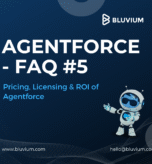
Agentforce FAQ #5 – Pricing, Licensing & ROI of Agentforce
As we continue our Agentforce FAQ Series, many organizations ask: “How much will Agentforce cost? What licensing models are available? When will we see a return on investment?” The good news is that Salesforce has recently updated its pricing and licensing structures to align more closely with usage and business outcomes.
Here’s what you need to know.
1. Pricing & Licensing Models
Flex Credits Model: Salesforce introduced a consumption-based model where actions that an agent performs consume “Flex Credits”. For example, 100,000 credits at USD $500 (≈ $0.10 per action).
Conversation-Based Pricing: Prior to or alongside Flex Credits, there’s a conversation-based model at approximately USD $2 per conversation for some customer-facing agents.
For more information on the pricing structure you can also check out: Link
User-License Add-ons & Editions:
Agentforce add-on for employees: ~$125 per user/month for unmetered employee-facing usage.
Agentforce Industries add-on: ~$150 per user/month for industry cloud usage.
Agentforce 1 Editions (Sales, Service, Field Service, Industries) start from ~$550 per user/month, including 1 M Flex Credits per org/year and Data Cloud credits.
User License (Employee-Facing): ~$5 USD/User/Month (requires Flex Credits) for certain deployments.
Important Notes/Examples:
- Example: 3 actions × 20 Flex Credits = 60 credits → USD $0.30 per “use-case” in one scenario.
- The pricing page emphasises that actual usage will vary; usage examples do not guarantee future cost.
2. What Drives Cost & How to Manage It
The number of actions the agent performs (in the Flex Credits model) or the number of conversations (in the conversation model) is the primary cost driver.
- Scope & maturity of deployment: A simple pilot use case vs. enterprise-wide multi-agent deployment vary dramatically in cost.
- Included usage vs add-ons: Some editions bundle Flex Credits and Data Cloud credits; organizations should check what’s included vs what will cost extra.
- Data readiness & environment complexity: Hidden costs include data preparation, licensing of supporting platforms (Data Cloud), and governance. Recent user commentary indicates hidden/ancillary costs remain a concern.
- Scaling behaviour & consumption forecasting: With Flex Credits, you’ll want good usage analytics, alerts, and governance to avoid unexpected cost spikes.
Organizations also need to factor in implementation & change-management overhead when calculating total cost of ownership.
3. Return-on-Investment (ROI) Insights & Benchmarks
According to a case-study on Agentforce’s multi-tier pricing strategy: Customers reported:
- ~27% increase in sales team productivity in one Flex Credits tier.
- ~42% reduction in customer churn for enterprise license tier.
Salesforce itself promotes ROI modelling tools: Their pricing page references an ROI estimator to project business value across Sales, Service, Field Service.
Key time-to-value levers: Start small (pilot), track metrics (response times, escalations, agent deflection), and scale with measurable business outcomes — this often brings value faster than full-scale deployments.
4. Best Practice Guidance for Organisations
- Start with a pilot use case: Choose high volume, standardised workflows to test ROI before scaling.
- Set clear KPIs: Track impact on productivity (e.g., agent hours freed), cost per interaction, case deflection, time-to-resolution.
- Monitor consumption: Use Salesforce’s Digital Wallet and analytics to track Flex Credit usage and avoid cost surprises. Salesforce
- Check licensing fits usage scenario: If employee-facing usages dominate, user-based add-on may be more predictable; if high action volumes, Flex Credits may be more efficient.
- Include supporting costs in the business case: Implementation, data work, governance, change management.
- Review the licensing and model annually: With dynamic pricing and evolving use cases, re-assess periodically.
5. Why Now is a Strategic Moment
With 2025 updates to pricing (Flex Credits, user licences, add-ons) and increasing enterprise focus on AI agents, organisations have more flexible paths to adopt Agentforce. These changes reduce barriers and tie cost more directly to business outcomes. That said, cost transparency and consumption monitoring remain critical for success.
Final Thoughts
For organisations evaluating or already using Agentforce, understanding pricing, licensing & ROI is central to maximising value. Using the right model, tracking usage, and aligning to measurable outcomes will differentiate successful deployments from those that struggle. Use this FAQ as your roadmap for the next step in your Agentforce journey.
Ready to model cost and ROI for your business? Reach out to us at hello@bluvium.com to explore how Agentforce pricing applies to your deployment and map a strategy tailored for you.





